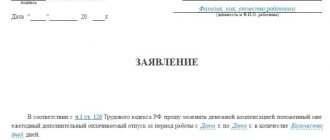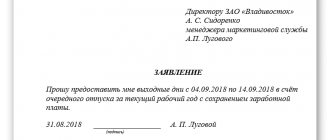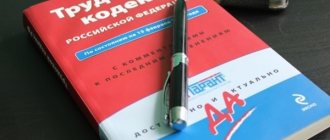Vacation - everyone has a right
The duration of the vacation is determined by the Labor Code of the Russian Federation. Most of those who work officially receive 28 calendar days of rest annually. All vacation days are paid by the employer.
Not only those employees who are permanently employed by the enterprise have the right to 4 weeks of rest. Other employees can also count on vacation. It refers to:
- part-time workers;
- who has concluded an employment relationship with the employer under a fixed-term contract;
- seasonal workers;
- homeworkers and those who work remotely.
The duration of the vacation period includes calendar days, including weekends. But if this period of time includes an idle non-working day, then it is not paid. It is not included in the duration of the vacation.
Northern vacation for part-time workers: nuances
Any types of paid leave for citizens working part-time are provided on a general basis (Article 321 of the Labor Code of the Russian Federation). But there are a number of nuances that characterize the implementation of this labor law norm in practice.
So, in Art. 287 of the Labor Code of the Russian Federation states that guarantees and compensation for workers in the Far North can only be provided at the main place of work. This provision makes many employers doubt the legality of part-time workers’ demands to provide leave. But Rostrud, in letter dated 06/08/2011 No. 1599-6-1, indicates that it only applies to targeted measures to support employees. In particular, those that may be assigned as a result of the dismissal of an employee due to the closure of the employer, staff reduction, those that involve the receipt of medical services, payment of travel expenses and baggage transportation.
Thus, part-time workers can, in principle, use vacation in the regions of the Far North and territories equivalent to it, as follows from the norms of Art. 321 Labor Code of the Russian Federation.
In the provisions of Art. 286 of the Labor Code of the Russian Federation states that leave for a part-time worker must be granted simultaneously with that which he enjoys at his main place of work, and if a person has not had time to work at an additional job for 6 months (the minimum length of service for main and northern leave), then in advance.
If the duration of the required vacation in a company in which a person works part-time is less than at his main place of work, he has the right to request leave from the company management at his own expense at the same time as that taken out at his main place of work. Theoretically, this is possible if at the main job a person is granted other additional leaves that are not provided at the place of part-time work - for example, for the same irregular working day.
What documents to request from an employee to account for income tax expenses if the employer paid for the travel of the employee and his family members to the place of vacation was explained by 3rd Class Advisor to the State Civil Service of the Russian Federation N. N. Taktarov. Get trial access to ConsultantPlus and study the official’s opinion for free.
What is extended leave?
The Labor Code establishes not only the standard duration of leave. The right to provide employees with more days of rest each year is provided. Their number ranges from 30 to 56. The specific number is determined by the Labor Code of the Russian Federation and other federal laws. Leave that exceeds 28 days in duration is called “extended main leave.”
Important! Only certain categories of employees and those who occupy certain jobs can count on extended leave. .
Categories of employees entitled to additional leave
The law includes the categories of workers who are entitled to additional leave: - minors who have not yet turned 18 years old; according to Article 267 of the Labor Code of the Russian Federation, they are entitled to rest for 31 calendar days; - disabled people who have the right to rest for at least 30 calendar days, in accordance with the Law “On Social Protection of Disabled Persons in the Russian Federation” No. 181-FZ of November 24, 1995; — workers with the title “Veteran of Labor” and elderly citizens who also have the right to extended leave of 30 calendar days; — workers whose working conditions are recognized as harmful and dangerous; — employees who, under the terms of an employment contract, work irregular working hours; — those who work in the Far North and other regions equivalent to them.
The law determines only the minimum duration of labor leave. Each company can set a longer vacation duration based on its financial capabilities.
Who can count on an extended vacation?
To obtain information about which of the employees has the right to take extended leave, you cannot do without studying the Labor Code. You should also familiarize yourself with Federal laws and other regulations.
The table contains information on the duration of extended leave for certain categories of employees:
| Categories of workers | Duration of vacation, days. | Explanation |
| Under 18 years of age | 31 | Leave is granted at the first request of the employee |
| Employees with disabilities | 30 | Relevant for all disability groups |
| Those employed in work related to chemical weapons | I group – 49 II gr. – 56 | The assignment of an employee's position to a specific group depends on the level of danger of the work performed. All information is in Federal Law No. 151 (1995) |
| Emergency rescue service and military personnel | 30 35 40 | The specific duration depends on the continuous length of service. All the information you need: here |
| Employees of the prosecutor's office, the Investigative Committee, judges, customs officers, drug police | 30 | The travel time to the vacation spot and back is not taken into account in these 30 days, it is counted separately. Vacation increases upon reaching a certain length of service |
| Employees of health care institutions who are exposed to the risk of HIV infection in their work | 36 | Applies to persons engaged in: – diagnosis and treatment of HIV-infected people; – examination of material containing HIV infection |
Important! In order not to make mistakes and set the correct vacation days, you should thoroughly study the regulatory documents.
Extended leave of 42 and 56 days: to whom and what type to provide
Teachers have two types of extended leave: 42 and 56 calendar days. In the article we will analyze the intricacies of granting such leaves: on what conditions the duration depends and to which categories of teaching staff to provide.
The employer is obliged to provide basic extended paid leave to teachers, heads of educational organizations and their deputies. The duration of leave, 42 or 56 calendar days, depends on the type of educational organization, the health characteristics of students and the position of teaching staff.
How many days should teaching staff rest?
Teachers whose positions are listed in the Nomenclature of Positions of Teaching Workers (subsection 2 of Section I) are entitled to extended leave. The length of leave depends on the type of educational organization and the health characteristics of students.
Kindergarten. Vacation for teaching staff of non-specialized kindergartens is 42 calendar days (clause 1 of Section I of the Appendix to Government Resolution No. 466 dated May 14, 2015). Teaching staff of kindergartens who work with students with disabilities or children who need long-term treatment have the right to leave 56 calendar days (clause 4 of section I of the appendix to Government Decree No. 466 dated May 14, 2015). These are teaching staff who:
- work in compensatory or health-improving groups;
- directly interact with these categories of children in combined groups.
Compensatory groups work according to an adapted educational program of preschool education for children with disabilities. Health-improving groups are created for children with tuberculosis intoxication, those who are often ill and other categories of children who need long-term treatment. Combined groups teach healthy children and children with disabilities (clause 13 of the Procedure approved by Order of the Ministry of Education and Science dated August 30, 2013 No. 1014).
At the same time, the number of children with whom the teacher works does not matter - there are no such restrictions in regulatory legal acts. That is, for a leave of 56 calendar days, it is enough for the teacher to work with at least one child with disabilities and (or) in need of long-term treatment.
School. The duration of extended leave for school teaching staff is 56 calendar days (clause 1 of section III of the appendix to Government Resolution No. 466 dated May 14, 2015). This also applies to workers who work in groups for preschoolers with disabilities, and children who need long-term treatment (clause 4 of section III of the appendix to Government Decree No. 466 dated May 14, 2015).
The exception is teachers and music directors who work only in groups for preschool children. The duration of leave for such employees is 42 calendar days (clause 5 of Section III of the Appendix to Government Resolution No. 466 dated May 14, 2015).
How many days should a kindergarten manager rest?
The duration of extended leave for managers may vary. It depends on the type of preschool educational organization and on whether the kindergarten has compensatory and health-improving groups.
Vacation 42 days. The duration of leave for the heads of general developmental kindergartens with care and health groups is 42 calendar days (clause 2 of section I of the appendix to Government Resolution No. 466 dated May 14, 2015). Heads have the same duration of leave if the kindergarten has only:
- separate groups of compensatory and health-improving orientation;
- combined groups, in which healthy children and children with disabilities are educated together.
Vacation 56 days. Heads of specialized preschool institutions for children with disabilities and for children who need long-term treatment have the right to extended leave of 56 days. Such kindergartens operate according to adapted general education programs for the following categories of pupils (Part 5 of Article 79 of Law No. 273-FZ of December 29, 2012):
- deaf;
- hearing impaired;
- late-deafened;
- blind;
- visually impaired;
- with severe speech impairments;
- with musculoskeletal disorders;
- with mental retardation;
- with mental retardation;
- with autism spectrum disorders;
- with complex defects;
- with other disabilities.
How many days should a school principal rest?
The duration of the school head's vacation is 56 calendar days (clause 2 of section III of the appendix to Government Decree No. 466 dated May 14, 2015). This is how all managers and their deputies rest, regardless of the specifics of the educational organization. Similar rules apply to heads of general educational organizations of music, sports, and art.
Lesnykh N.V.
Features of providing extended leave to education workers
Leave for workers engaged in practical or theoretical educational activities has always been longer than standard. According to modern legislation, these employees receive rest time of the following duration:
| Employees | Duration of vacation, days. | Explanation |
| Working in preschool and general education institutions, additional education organizations | 42 or 56 | The number of days depends on the employee’s position and the type of educational organization where he works. full information |
| Candidates of Science Doctors of Science | 36 48 | Working days are counted, not calendar days. Scientists work on the staff of research organizations funded from the federal budget: see here |
Important! For employees of scientific government institutions with scientific degrees, extended leave is taken not on calendar days, but on working days.
Additional holidays
The minimum duration of additional vacations that employees are entitled to is established in the Labor Code, other laws and regulations. The most common cases when additional leave is provided, as well as their duration, are shown in the table.
Situation: how to provide additional leave to an internal part-time Chernobyl survivor?
In this case, the Chernobyl survivor is entitled to additional leave on two grounds: both part-time and at the main place of work. However, this does not mean that he will rest twice as long.
Part-time workers are given leave simultaneously with rest from their main job. That is, if an internal part-time Chernobyl survivor takes annual leave, including additional leave, at his main place of work, then he uses the same number of rest days as a part-time worker.
But he needs to calculate vacation pay twice: for vacations at his main place of work and for the position he combines. This procedure follows from Part 2 of Article 287 and Part 1 of Article 286 of the Labor Code of the Russian Federation.
Situation: how to establish the duration of additional leave for employees engaged in harmful and dangerous work?
Specify the duration of additional leave in the collective agreement, guided by current regulations.
As a general rule, employees are entitled to additional leave:
- for harmful and (or) dangerous working conditions, confirmed by workplace certification carried out before January 1, 2014;
- for hazardous working conditions of the 2nd, 3rd or 4th degree or for hazardous working conditions confirmed by a special assessment of working conditions carried out after January 1, 2014.
The duration of leave for harmful and (or) dangerous working conditions cannot be set to less than seven calendar days. At the same time, the maximum duration of additional leave is not limited (Article 117 of the Labor Code of the Russian Federation).
The procedure for determining the specific duration of additional leave depends on the results of the event that determined the working conditions: certification of workplaces or a special assessment of working conditions.
Working conditions are determined based on the results of workplace certification
The requirement to determine working conditions based on the results of certification was in effect until January 1, 2014, in accordance with the order of the Ministry of Health and Social Development of Russia dated April 26, 2011 No. 342n. If after this the working conditions have not been revised, then the duration of the additional leave can be found out from the following documents:
- the list, which was approved by the Decree of the State Committee for Labor of the USSR and the Presidium of the All-Union Central Council of Trade Unions dated October 25, 1974 No. 298/P-22;
- Instruction approved by Resolution of the State Committee for Labor of the USSR and the Presidium of the All-Union Central Council of Trade Unions dated November 21, 1975 No. 273/P-20.
These documents are still in force and have not been cancelled. But they need to be applied only in those parts that do not contradict the Labor Code (Article 423 of the Labor Code of the Russian Federation).
Such conclusions are confirmed by the position expressed in the ruling of the Supreme Court of the Russian Federation dated November 1, 2012 No. APL12-651, the decision of the Supreme Court of the Russian Federation dated January 14, 2013 No. AKPI12-1570, clarifications of the Ministry of Labor of Russia dated February 13, 2013.
If your industries, professions and positions are not on the list, then set the duration of additional leave yourself in a collective agreement or other local act. It cannot be less than the established limit and must take into account the specific working conditions.
Working conditions are determined based on the results of a special assessment
After January 1, 2014, the harmfulness and danger of work is determined based on the results of a special assessment. It is carried out in the manner prescribed by Law of December 28, 2013 No. 426-FZ.
In this case, determine the duration of additional leave for each specific employee yourself. If there are industry (inter-industry) agreements, be guided by them. The deadline found in this way should be fixed in the collective agreement and employment contract with the employee. Such rules are established by Article 117 of the Labor Code of the Russian Federation.
Additional paid leave is provided only for time actually worked in harmful and (or) dangerous conditions (Article 121 of the Labor Code of the Russian Federation). Taking this into account, calculate the duration of such leave in proportion to the time actually worked:
| Duration of additional leave for work in hazardous working conditions | = | Duration of additional leave provided for a year of work in hazardous working conditions (in accordance with the employer’s internal documents) | : | 12 months | × | Number of full months worked in hazardous working conditions |
Do the same when an employee works in hazardous conditions only from time to time (clause 13 of the Instruction approved by the Decree of the State Committee for Labor of the USSR and the Presidium of the All-Union Central Council of Trade Unions dated November 21, 1975 No. 273/P-20, letter of Rostrud dated March 18, 2008 No. 657- 6-0).
Part-timers
Part-time workers also have the right to additional leave due to hazardous working conditions. However, the following must be taken into account. The length of service that gives the right to additional leave includes only the time actually worked under the appropriate conditions. That is, they take into account only those days when the employee worked in hazardous or hazardous industries for at least half of the time established for them in a day (clause 12 of the Instruction, approved by the Resolution of the State Committee for Labor of the USSR and the Presidium of the All-Union Central Council of Trade Unions dated November 21, 1975 No. 273/P-20, Part 2 of Article 287, Article 121 of the Labor Code of the Russian Federation).
An example of calculating the duration of additional leave for temporary work in hazardous working conditions
A mechanic is periodically tasked with electrical welding work indoors. For such work, the collective agreement of the organization establishes an additional annual leave of 24 calendar days.
The employee worked in hazardous conditions for a month. All this time he worked full time (he was released from his main job). He is entitled to additional leave of the following duration: 24 days. : 12 months × 1 month = 2 days
There is no question about calculating the duration of leave if the employee has worked the full number of months on the date of going on leave. However, in practice, situations are not so simple. For example, during the billing period, an employee could be sick, on leave without pay, etc. Then, before calculating the duration of additional leave, it is necessary to determine the exact number of months that the employee worked in harmful and dangerous working conditions. To do this, use the following formula:
| Number of full months worked in hazardous working conditions | = | Number of days actually worked in hazardous working conditions during the working year (before the date of leave) | : | Average monthly number of working days |
Part of the additional leave for harmful and dangerous working conditions exceeding seven calendar days can be replaced with monetary compensation under the following conditions:
- such a possibility is provided for by an industry (inter-industry) agreement and a collective agreement;
- this has the written consent of the employee himself, drawn up in the form of an additional agreement to the employment contract.
The amounts, as well as the conditions for payment of compensation, are established by industry (inter-industry) agreements and collective agreements.
Such norms are contained in Article 117 of the Labor Code of the Russian Federation.
Situation: how to determine the average monthly number of working days to calculate the number of full months worked in hazardous conditions? The organization provides the employee with additional leave for working in hazardous conditions.
To calculate this indicator, you can use data from the production calendar for the current year.
Calculate the average monthly number of working days using the formula:
| Average monthly number of working days | = | Number of working days in the current year according to the production calendar | : | 12 months |
Situation: how to provide an employee who has suffered a work injury with leave for sanatorium treatment - as part of the main or additional leave?
As part of additional leave.
This is expressly established in law. If an employee receives an industrial injury, then the employer, based on the employee’s application, provides him with additional leave for the entire period of treatment in a sanatorium-resort institution (including travel time to the place of treatment and back) (Article 116 of the Labor Code of the Russian Federation, paragraph 7 of Article 15 of the Law dated July 24, 1998 No. 125-FZ).
At the same time, you can pay for the trip through contributions for insurance against accidents and occupational diseases. But only if the following conditions are met:
- a voucher to a sanatorium-resort institution was issued by the Federal Social Insurance Fund of Russia;
- the decision on the need for sanatorium-resort treatment was made by a medical and social examination.
If both conditions are met, contributions from accidents and occupational diseases can be reduced by vacation pay. This follows from paragraph 5 of the Regulations approved by Decree of the Government of the Russian Federation dated May 15, 2006 No. 286, and subparagraph 2 of paragraph 9 of the Rules approved by Decree of the Government of the Russian Federation dated March 2, 2000 No. 184.
How to arrange an extended vacation
The sequence for registering an extended vacation is standard:
- Write a statement addressed to the manager. Indicate in it the start date of the vacation and the number of days (if the vacation is taken in parts).
- Submit the application to the HR officer. If the numbers correspond to the vacation schedule, the document will be sent to the manager.
- When the employer endorses the application, an order is issued to grant leave.
- The employee reads the order and puts his signature on it.
- The accountant receives a copy of the order and calculates the vacation pay.
- The employee is given the amount at the cash desk, or it is credited to his bank card.
Important! Vacation pay is paid to the employee no later than 3 days before the vacation.
Vacation compensation in the Far North
We noted above that the number of rest days can be formed from those represented by the northern vacation and those corresponding to the main vacation. However, this does not mean that the corresponding leaves have the same legal status in other legal relations.
So, if we are talking about vacation compensation (payment of vacation pay, provided that the employee remains at work for the corresponding period and continues to receive a salary), then the main vacation (28 days) cannot be compensated (Article 126 of the Labor Code of the Russian Federation).
In turn, vacation in the Far North, as well as the main one unused in previous years (provided that it was formed after compulsory 28 days off per 1 year of work), can be compensated, except in cases where employment contracts are concluded with pregnant women and minors.
All types of unused vacation are compensated upon dismissal of an employee (Article 127 of the Labor Code of the Russian Federation).
Read more about compensation paid without dismissal here.
Features of dividing an extended vacation into parts
Employees who take longer vacations than usual have the right not to use all their vacation days at once. They can be divided into several components by fulfilling the following conditions:
- The duration of one part of the vacation is at least 14 days.
- Consent of both parties.
The number of vacation days is calculated depending on the employee’s period of work in the organization.
An employee has the right to basic leave after six months of continuous work. The employer is not prohibited from:
- provide annual holidays in advance;
- invite the employee to use only those vacation days that have already been “earned.”
Example. The university professor worked for six months and applied for leave. An employer can, without fear of overpayment of vacation pay, provide a subordinate with the following number of vacation days:
56 days/2 = 28 calendar days.
But the rector has the right not to deny the professor leave in advance, unless this negatively affects the educational process and the work of the university as a whole.
Registration procedure
An extended vacation can be divided into parts in the same way as a regular one, and one of these parts must be no shorter than 14 days.
According to Letter of Rostrud No. 2143, excessive splitting of vacation is not recommended, and assigning vacation for short periods consisting only of weekends and holidays is not allowed.
Registration of extended leave occurs in the following order:
- The employee submits a statement to the HR department regarding preferred vacation dates and periods for the coming year.
- The application is reviewed and agreed upon with the head of the department.
- A vacation schedule for the next calendar year is drawn up and approved.
- Appropriate notes are entered into index cards and time sheets.
- A copy of the vacation schedule is sent to the accounting department to calculate vacation payments.
The vacation schedule is signed by the head of the department or general director 2 weeks before the new year. This document is mandatory for both employees and the company’s management, and changes to the schedule after it has been signed and the employees have become familiar with it are allowed only by agreement of the parties and the trade union committee of the enterprise.
The application for leave must indicate:
- full name of the enterprise and structural unit;
- Full name of the head;
- Full name, position and personnel number of the applicant;
- number of parts into which the extended vacation needs to be divided;
- duration of each vacation period in days , start and end date;
- date and signature.
A sample application for extended leave can be viewed here.
Employees entitled to increased paid leave are additionally entitled to annual leave at their own expense lasting from 14 to 28 days, depending on the nature and working conditions. The employee may indicate in the application his desire to use part of the vacation days at his own expense at the beginning or end of the extended vacation or part thereof.
Some questions and answers
Question No. 1. The head of a department in a scientific organization has a scientific degree of Candidate of Sciences. How long is his vacation?
Answer. An employee can count on 48 working days of vacation.
Question No. 2. The manager of the enterprise is a disabled person of the 3rd group. He worked for 11 months and applied for leave for 30 days. Management insists he can only claim 28 cal. days. Who is right?
Answer. Working disabled people, regardless of disability group, receive extended leave - 30 calendar days. Therefore, management will violate the law if it gives its employee 2 less days. Read more here
What are the rules for calculating the duration of vacation?
The total duration of paid leave for a working year can be determined as follows:
| Total duration of paid leave | = | Duration of basic (extended) paid leave | + | Days of additional paid leave |
There is no limit on the duration of rest in a calendar year. So, if a person has accumulated unused days, he can, in agreement with the employer, take them all off at once. Let’s say an employee is entitled to annual basic paid leave of 28 calendar days. And over the last two working years he did not have 40 days of vacation. An employee has the right to use all these days within one calendar year.
All this is established by articles 115 and 120 of the Labor Code of the Russian Federation.
When determining the duration of vacation, exclude non-working holidays from the calculation: both federal ones - those prescribed in Article 112 of the Labor Code of the Russian Federation, and regional ones. The latter are established by the authorities of the constituent entities of the Russian Federation. This follows from Articles 22, 120 of the Labor Code of the Russian Federation and paragraph 2 of the letter of Rostrud dated September 12, 2013 No. 697-6-1, part 1 of Article 72 of the Constitution of the Russian Federation, Article 4 of the Law of September 26, 1997 No. 125-FZ.
An example of how to determine the duration of annual basic paid leave that includes a holiday
P.A. Bespalov has been working at Alpha LLC as a storekeeper for more than two years. He has accumulated unused days of annual basic paid leave. Bespalov decided to use them - on May 15, he wrote an application for leave from June 1 to June 21, 2015.
To calculate vacation pay, the accountant calculated the total duration of Bespalov's vacation. June 12, 2015 is a non-working holiday (Article 112 of the Labor Code of the Russian Federation). Therefore, the accountant excluded it from the calculation. Thus, the duration of Bespalov’s vacation was 20 calendar days – from June 1 to June 11 and from June 13 to June 21, 2015.
An example of how to determine the end date of annual basic paid leave of 28 calendar days, if it was granted from April 11
P.A. Bespalov has been working at Alpha LLC as a storekeeper for more than two years. The work schedule is variable with variable days off. He has accumulated unused days of annual basic paid leave. Bespalov decided to use them - on March 15, he wrote an application for leave from April 11, 2015 for 28 calendar days.
May 1 and 9 are non-working holidays (Article 112 of the Labor Code of the Russian Federation). Therefore, the accountant did not include them in the number of vacation days. The duration of Bespalov's vacation is 28 calendar days. Namely from April 11 to April 30, from May 2 to May 8 and May 10, 2015.
The end date of the vacation in this case will be May 10, 2015. Therefore, if the shift is scheduled to fall on May 11, then it is on this day that Kondratiev must go to work.
But if the employee had a standard five-day schedule, he would go to work on May 12. The fact is that according to the production calendar for 2015, May 11 (Monday) is a day off.
Situation: what is the duration of the annual main leave of an external part-time worker?
28 calendar days.
Despite the fact that external part-time workers work part-time, they can take vacation on a general basis. That is, the duration of the annual basic paid leave for such employees is also 28 calendar days. All this follows from Part 2 of Article 287, Article 284 and Part 1 of Article 115 of the Labor Code of the Russian Federation.
Situation: what is the duration of annual basic leave for home-based employees?
28 calendar days.
For such employees, the general rules of labor legislation apply (Part 4, Article 310 of the Labor Code of the Russian Federation).
It is worth noting that the regulatory document that was in force in the USSR and has not yet been repealed contains a different number - 15 working days (clause 18 of the Regulations approved by the Decree of the State Committee for Labor of the USSR, the Secretariat of the All-Union Central Council of Trade Unions dated September 29, 1981 No. 275/17-99 ). However, in this part (regarding the duration of leave), this resolution contradicts the Labor Code. There is no need to apply this resolution (Article 423 of the Labor Code of the Russian Federation).
Regarding vacations of employees of organizations in Crimea and the city of Sevastopol, special rules must be observed, which are provided for by Law No. 299-FZ of October 14, 2014. What is important here is the date when the employment contract was concluded with the person. There are two options.
Option 1. The employment contract was concluded before October 15, 2014. Then leave for the period of work before January 1, 2015 should be provided according to the legislation in force in the territory of Crimea before joining Russia. That is, the duration of the annual main leave is 24 calendar days (Article 6 of the Law of Ukraine dated November 15, 1996 No. 504/96-BP).
Option 2. The employment contract was concluded on October 15, 2014 or later. In this case, the total duration of vacation is usually 28 calendar days (Article 115 of the Labor Code of the Russian Federation).
Such rules are provided for in paragraph 4 of Article 3, Article 6 of the Law of October 14, 2014 No. 299-FZ.
How can you share annual leave?
An employee can take annual leave of a total duration at one time or take several vacations a year. That is, by agreement between the employee and the organization, vacation can be divided into parts. There is no need to complete any additional documents. It is enough to reflect the date of granting each part of the vacation in the vacation schedule.
At least one part of the divided vacation must be at least 14 days. The employee can use the remaining days as he pleases. If the administration of the organization does not object, then he has the right to use even a few days of vacation from the remaining half.
This procedure for dividing annual leave into parts is provided for in Article 125 of the Labor Code of the Russian Federation.
An example of dividing annual basic leave into parts
By agreement with the administration of the organization, accountant V.N. Zaitseva, whose vacation is 28 calendar days, decided to divide her vacation time into several parts. She's taking a vacation:
- from January 16 to January 18 inclusive (3 days);
- from March 12 to March 17 inclusive (6 days);
- from July 2 to July 18 inclusive (17 days);
- from August 1 to August 2 inclusive (2 days).
The provision of leave in this manner was reflected in the organization's leave schedule.











